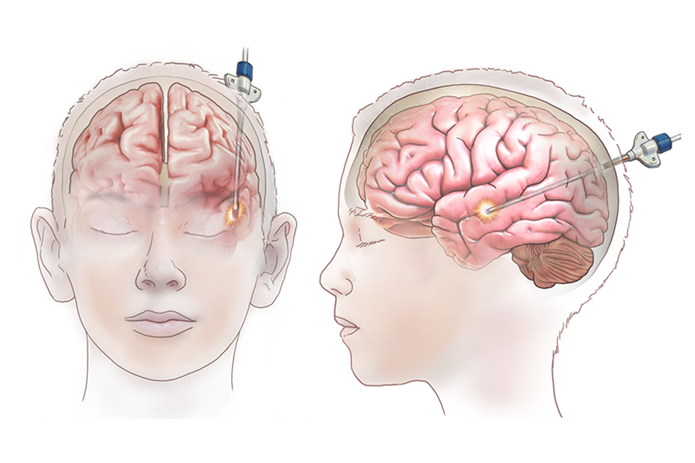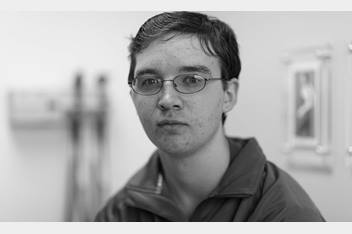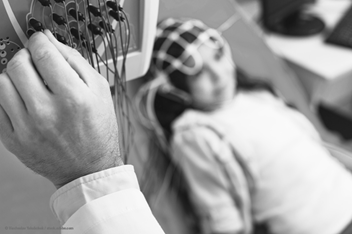Laser Ablation for Epilepsy
What Is Laser Ablation?
Laser ablation, also known as laser interstitial thermal therapy (LITT), is a minimally invasive surgical procedure used to reduce seizures in children with epilepsy. It works by using a laser, guided by MRI, to precisely target and treat the small areas of the brain that are causing seizures. Because it focuses only on the problem areas and avoids healthy brain tissue, laser ablation typically results in less damage, fewer side effects, and a faster recovery compared to traditional brain surgery.
Who Is a Candidate for Laser Ablation?
Every child’s epilepsy journey is unique. The epilepsy team will review your child’s medical history, medical imaging, and tests at a surgical conference. The team might recommend laser ablation if:
- Seizures aren’t controlled by medication: Your child’s seizures continue even after trying different anti-seizure medicines.
- Medication side effects: Your child experiences serious side effects from anti-seizure medicines.
- Seizures come from one specific area: Your child has specific types of seizures that can be pinpointed to one area of the brain.
This treatment is especially useful for certain types of epilepsy, such as mesial temporal sclerosis (MTS), a condition where scarring in the temporal lobe of the brain triggers seizures. Laser ablation can precisely target and treat this scar tissue without affecting surrounding healthy brain tissue.Laser ablation is also used for other seizure-related conditions, such as small brain lesions, focal cortical dysplasia, or hypothalamic hamartomas, when these are identified as the source of seizures. Because laser ablation is minimally invasive, it can be a safer option for children who might not be candidates for traditional open brain surgery.
What Are the Benefits of Laser Ablation?
Laser ablation has many benefits for children with epilepsy, especially when compared to traditional brain surgery. Because it is a minimally invasive procedure, it involves only a small incision and a thin laser probe, which means less damage to healthy brain tissue and fewer risks of complications. Using MRI guidance, the laser can accurately target the part of the brain causing seizures, making it very effective for conditions like mesial temporal sclerosis and focal brain lesions. This accuracy also helps protect the surrounding healthy tissue, reducing the chances of side effects like memory or movement problems.Recovery from laser ablation is usually faster than with traditional surgery. Many children can leave the hospital within one to two days and get back to normal activities sooner. In addition to better seizure control, many children experience fewer and less severe seizures, greatly improving their safety and quality of life. For children who are not candidates for open brain surgery, laser ablation is a safe and effective option for treating epilepsy.

What Are the Risks of Laser Ablation?
Laser ablation surgery uses tools and techniques to maximize safety. Despite this, there are still some risks, including:
- Damage to nearby brain tissue: The heat from the laser could affect areas outside the target zone, potentially causing issues with memory, movement, or speech, depending on the area treated.
- Bleeding or infection: There is a chance of bleeding or infection at the incision site or the small opening in the skull.
- Swelling in the brain: Swelling could occur after the procedure and might require additional treatment if it leads to increased pressure.
- Continued seizures: While laser ablation is effective for many cases, it may not completely stop seizures in all children.
- Temporary side effects: Headaches, fatigue, or discomfort during recovery are possible but usually improve quickly.
What Happens During Laser Ablation?
During the procedure, your child will be under general anesthesia to ensure they are asleep and pain-free. The surgeon will make a small incision in the scalp and a tiny opening in the skull. A thin laser probe will be carefully guided into the exact area of the brain causing seizures.Once it is in place, the laser will deliver controlled heat to destroy the seizure-causing tissue under MRI guidance. The healthy brain tissue around it is protected. After the targeted area is treated, the laser probe is removed, and the incision is closed with stitches or glue.
What Happens After Laser Ablation?
After the surgery, your child will be transferred to a recovery area where they will wake up from anesthesia. Doctors and nurses will closely monitor their healing. The surgical site will be checked regularly, and your child’s care team will watch for any signs of complications, such as swelling or infection.Your child may feel some mild discomfort or headaches, which are usually managed with pain medication. Most children can go home within one or two days after the procedure. Your child will continue their anti-seizure medicines at the usual doses and see the Neurology doctor a few weeks after surgery.
Medical Reviewer: Ammar Shaikhouni, MD, PhD, Nationwide Children's Hospital
Date Last Reviewed: 7/25/2025
The information provided here is only for general reference and should not take the place of medical care or patient education. If you have any questions, please call our Epilepsy Surgery Clinic at (614) 722-4625.


